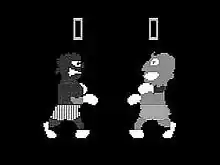Heavyweight Champ
Heavyweight Champ is a series of boxing video games released by Sega. The original game was released in 1976. The game featured black-and-white graphics and critics have since identified it as the first video game to feature hand-to-hand fighting.[3][4][5] Sega released a remake to arcades in 1987, changing the side perspective of the original game to a third-person viewpoint from behind the boxer. Both games feature unique controls that simulate throwing actual punches.[3] The 1976 game is considered a lost video game.[6]
| Heavyweight Champ | |
|---|---|
 Arcade flyer for the 1987 game | |
| Developer(s) | Sega |
| Publisher(s) | Sega |
| Series | Heavyweight Champ |
| Platform(s) | Arcade |
| Release | October 1976 (original),[1] September 1987 (remake)[2] |
| Genre(s) | Sports Fighting |
Gameplay

The 1976 original featured gameplay viewed from a side-view perspective. It employed two boxing glove controllers, one for each player, which moved up and down for high and low punches, with an inward movement for striking.[3] It used large monochrome sprite visuals for the graphics.[7]
The 1987 game changed the perspective to behind the player's boxer. In addition, the player is given two punch controllers, one for each hand. Only a single-player mode was made available, in which the player faces a series of opponents in one-round, three-minute bouts. Players can swivel the cabinet to move their boxer from side to side.[8]
Reception
The 1987 remake was well received. In Japan, Game Machine listed the 1987 version on their November 15, 1987 issue as being the fourth most-successful upright arcade unit of the year.[9] Advanced Computer Entertainment and Commodore User praised the game's unique controls but raised concerns that they might decrease the lifespan of the cabinets.[10][11] Commodore User also had positive impressions of the game's graphics and gave the game a 9 out of 10 overall. [12]
Related games
Sega reused the Heavyweight Champ name when they released the Sega Master System version of James "Buster" Douglas Knockout Boxing outside of North America. The game features a side perspective and is otherwise unrelated to the arcade games. It was not received well.[13][14][15]
The 1991 Sega arcade game Title Fight also featured controls for left and right punches and a similar behind-the-boxer perspective as the 1987 game, along with two-player gameplay through use of a dual-monitor cabinet.[16]
References
- "Heavyweight Champ (1976) Release Information for Arcade Games - GameFAQs". Gamefaqs.com. Retrieved 8 October 2017.
- "Heavyweight Champ arcade video game pcb by SEGA Enterprises, Ltd. (1987)". Arcade-history.com. Retrieved 8 October 2017.
- Spencer, Spanner, The Tao of Beat-'em-ups, EuroGamer, Feb 6 2008, Accessed Feb 23, 2009
- Ashcraft, Brian, (2008) Arcade Mania! The Turbo-Charged World of Japan's Game Centers, (Kodansha International), p. 94
- Nadia Oxford, 20 Years of Street Fighter, 1UP.com, 12/11/2007
- "Heavyweight Champ". Ultimate History of Video games. Retrieved 8 October 2017.
- Loguidice, Bill; Barton, Matt (24 February 2014). Vintage Game Consoles: An Inside Look at Apple, Atari, Commodore, Nintendo, and the Greatest Gaming Platforms of All Time. CRC Press. ISBN 9781135006518. Retrieved 8 October 2017 – via Google Books.
- "Heavyweight Champ (1987)". International Arcade Museum. Retrieved January 3, 2012.
- "Game Machine's Best Hit Games 25 - アップライト, コックピット型TVゲーム機 (Upright/Cockpit Videos)". Game Machine (in Japanese). No. 320. Amusement Press, Inc. 15 November 1987. p. 25.
- "Heavyweight Champ". Advanced Computer Entertainment. March 1988. p. 26.
- "Heavyweight Champ. Commodore User. December 1987. p. 144
- Kelly, Nick. "Heavyweight Champ. Commodore User. January 1988.
- Heavyweight Championship Boxing. Mean Machines. Issue 7. pp 58-59.
- Heavyweight Champ. Raze. Issue 9. p. 54.
- Heavyweight Championship Boxing. CVG's Complete Guide to Sega. pp. 95-96.
- Title Fight. Killer List of Video Games. Retrieved January 3, 2013.